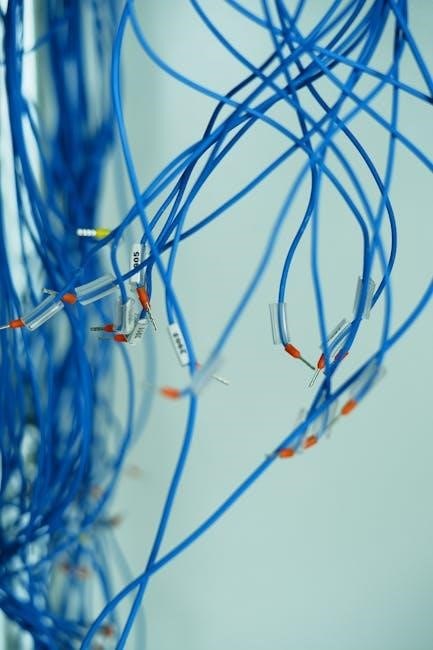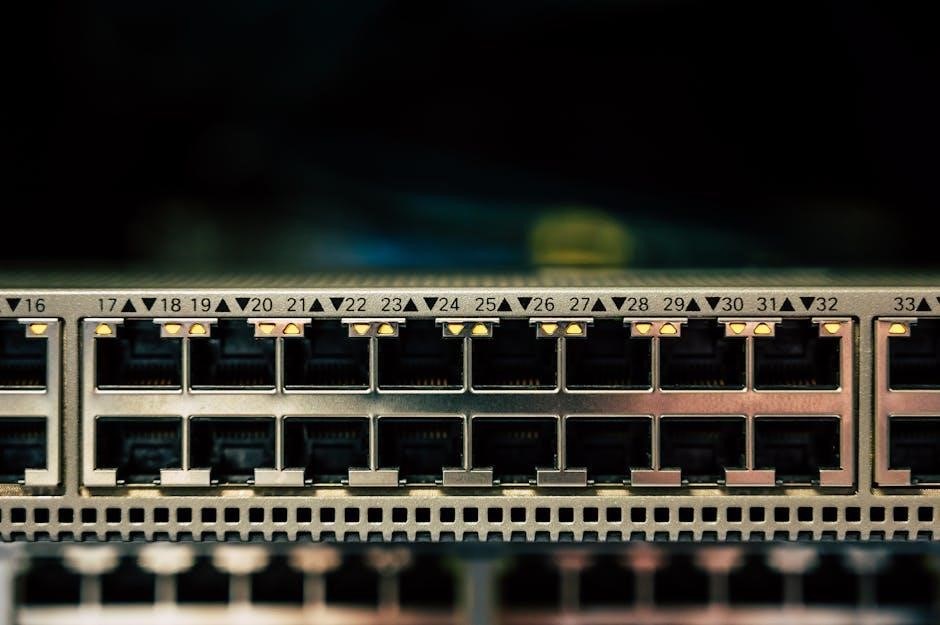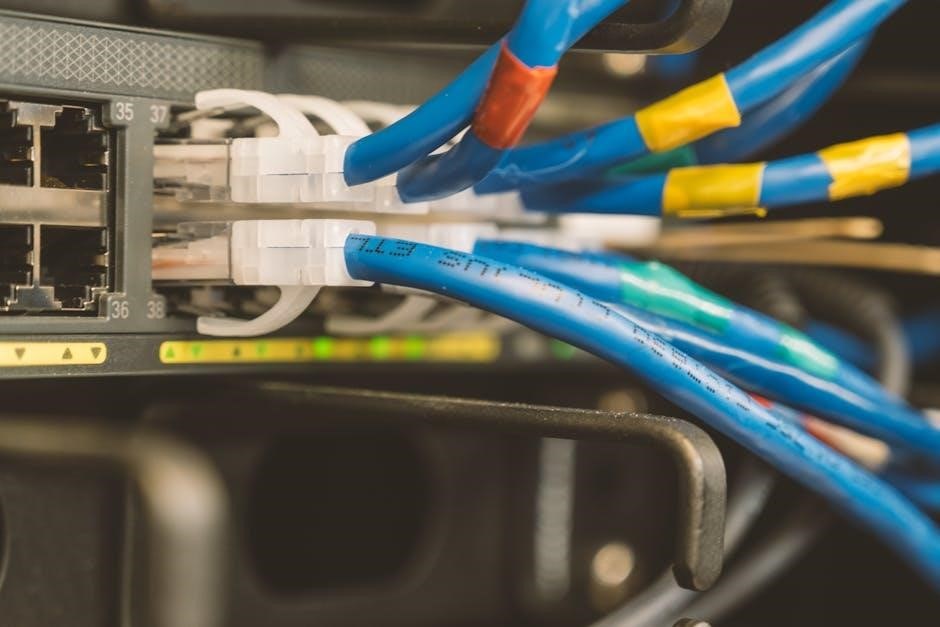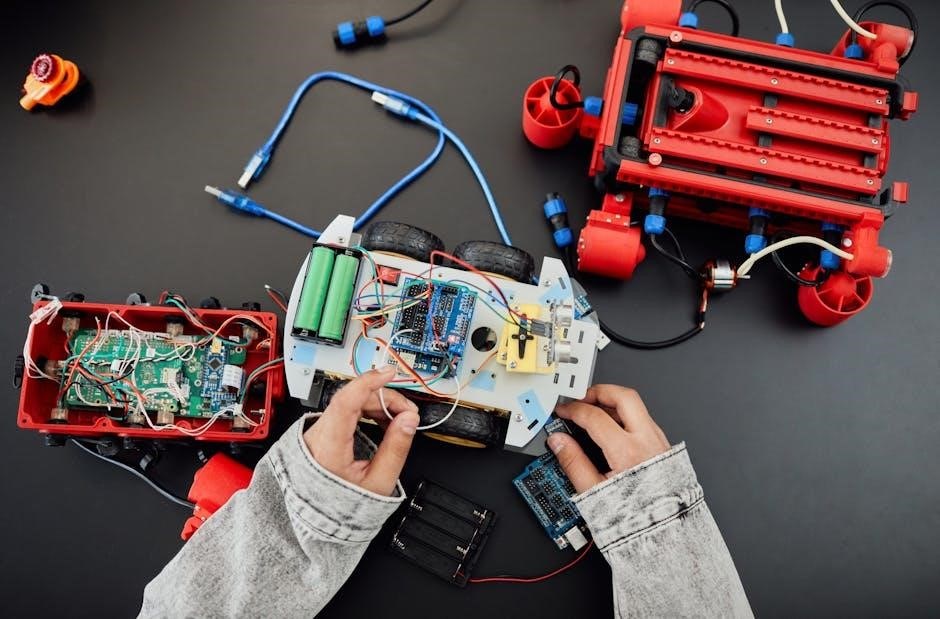Ethernet cable wiring guide provides essential information on setting up networks using
various cables
and connectors to establish reliable connections between devices using standard protocols and procedures always.

Definition of Ethernet Cable
An Ethernet cable is a type of networking cable used to connect devices to a local area network or wide area network‚ typically using RJ45 connectors and twisted-pair wiring to reduce electromagnetic interference.
The cable consists of multiple pairs of twisted copper wires‚ with each pair carrying a specific signal‚ and is commonly used for internet connections‚ computer networking‚ and other data transmission applications.
Ethernet cables are defined by standards such as Category 5‚ Category 6‚ and Category 7‚ which specify the cable’s bandwidth‚ speed‚ and other performance characteristics‚ making them suitable for various networking needs and requirements.
The definition of an Ethernet cable is closely tied to its ability to transmit data quickly and reliably‚ making it a crucial component of modern computer networks and telecommunications systems‚ enabling fast and efficient communication between devices.
Ethernet cables play a vital role in facilitating communication and data exchange between devices‚ and their definition is essential to understanding their function and importance in networking applications.
Importance of Ethernet Cable Wiring
Ethernet cable wiring is crucial for establishing a reliable and efficient network connection‚ enabling devices to communicate with each other and exchange data quickly and accurately.
Proper wiring ensures that signals are transmitted without interference or degradation‚ reducing errors and downtime‚ and improving overall network performance and productivity.
Correctly wired Ethernet cables also help to prevent data loss and corruption‚ ensuring that sensitive information is transmitted safely and securely.
The importance of Ethernet cable wiring lies in its ability to support high-speed data transmission‚ making it essential for applications that require fast and reliable connectivity‚ such as online gaming‚ video streaming‚ and cloud computing.
By following proper wiring guidelines and best practices‚ users can ensure that their Ethernet cables are wired correctly‚ providing a stable and efficient network connection that meets their needs and expectations‚ and supports their daily activities and operations.

Types of Ethernet Cable Wiring
Various Ethernet cable wiring types exist‚ including different configurations and setups‚ to support various network architectures and applications always using standard protocols and procedures correctly.
Straight-Through Cable Wiring
Ethernet cable wiring guide provides information on straight-through cable wiring‚ which is used to connect devices of different types‚ such as computers to switches or routers.
The straight-through wiring method is the most common type of Ethernet cable wiring‚ and it is used in most local area networks.
This type of wiring uses the same wiring pattern at both ends of the cable‚ which means that the wires are connected to the same pins at both ends.
The straight-through cable wiring is easy to install and requires minimal configuration‚ making it a popular choice for many network installations.
It is also the most compatible type of wiring‚ as it can be used with most devices and networks‚ and it supports a wide range of network protocols and applications‚ including internet and intranet connections.
This makes it a versatile and reliable choice for many networking needs‚ including home and business networks‚ and it is widely used in many different types of networks.
Crossover Cable Wiring
Crossover cable wiring is a type of Ethernet cable wiring that is used to connect two devices of the same type‚ such as computer to computer or switch to switch.
This type of wiring is necessary because devices of the same type have the same wiring pattern‚ and a straight-through cable would not work.
The crossover cable wiring swaps the transmit and receive wires‚ allowing the devices to communicate with each other.
Crossover cables are commonly used in peer-to-peer networks‚ where devices need to communicate directly with each other.
They are also used in some network configurations‚ such as when connecting two switches or routers together.
The crossover cable wiring is an essential part of Ethernet cable wiring‚ and it is used in many different types of networks‚ including small office and home networks‚ and it requires a specific wiring pattern to function correctly and reliably.

Standards for Ethernet Cable Wiring
Ethernet cable wiring standards are defined by organizations to ensure compatibility and reliability of networks using specific protocols and procedures always following strict guidelines and rules precisely.
EIA/TIA 568A and EIA/TIA 568B
The Electronic Industries Association and Telecommunications Industry Association have defined two standards for Ethernet cable wiring‚ EIA/TIA 568A and EIA/TIA 568B‚ which are widely used in networking. These standards specify the wiring patterns for Ethernet cables‚ including the arrangement of wires and the color coding of the wires. The EIA/TIA 568A standard uses a green-white‚ green‚ orange-white‚ and orange color scheme‚ while the EIA/TIA 568B standard uses an orange-white‚ orange‚ green-white‚ and green color scheme. Both standards are compatible with each other and can be used interchangeably in most cases. The choice of standard usually depends on personal preference or the specific requirements of the network. Understanding these standards is essential for setting up and maintaining reliable Ethernet connections. Using the correct standard ensures that devices can communicate effectively and reduces the risk of errors or connectivity issues.
Wiring Diagrams
Wiring diagrams are visual representations of the wiring configuration used in Ethernet cables. They illustrate the arrangement of wires and the connections between devices‚ making it easier to understand and implement the wiring. These diagrams typically show the color coding of the wires and the pin assignments for the connectors; Wiring diagrams are essential for installing and troubleshooting Ethernet cables‚ as they provide a clear and concise guide for connecting devices. By following a wiring diagram‚ individuals can ensure that their Ethernet cables are properly wired and functional. The diagrams can be found in various resources‚ including online tutorials and networking manuals. They are a crucial tool for anyone working with Ethernet cables‚ providing a straightforward and easy-to-follow guide for wiring and connecting devices. Using wiring diagrams helps to reduce errors and ensures reliable connections.

Tools and Components Needed
Required tools include
crimpers
and cable testers for efficient wiring and connection processes always.
Ethernet Cable Connectors and Crimping Tools
Ethernet cable connectors are essential components in the wiring process‚ providing a secure connection between the cable and devices. Crimping tools are used to attach these connectors to the cable‚ ensuring a reliable and stable network connection. The quality of the connectors and crimping tools can significantly impact the performance of the network. It is crucial to choose the right type of connector and tool for the specific cable and application. A good quality crimping tool can make a significant difference in the reliability and speed of the network. The connectors and tools should be compatible with the cable and device standards to ensure optimal performance and minimize errors. Proper use of these tools and connectors is vital for a successful and efficient Ethernet cable wiring process‚ requiring attention to detail and adherence to standards. Ethernet cable wiring guide provides guidance on this.
Safety Precautions
When working with Ethernet cable wiring‚ it is essential to take necessary safety precautions to avoid injuries and damage to equipment. This includes wearing protective gear such as gloves and safety glasses. It is also crucial to ensure the work area is well-ventilated and clear of any flammable materials. Additionally‚ one should be aware of potential electrical hazards and take steps to prevent them. Proper handling and storage of cables and tools can also help prevent accidents. It is recommended to follow established safety guidelines and best practices when working with Ethernet cable wiring. By taking these precautions‚ individuals can minimize risks and ensure a safe working environment. Following safety protocols is vital for a successful and incident-free Ethernet cable wiring experience‚ and it requires attention to detail and adherence to established standards and procedures always.
